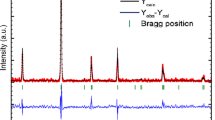Abstract
The low temperature resistivity and magnetoresistance of bulk samples of La1−x K x MnO3 has been investigated between 10 K and 300 K with and without the magnetic field (H=0·8 T). All the samples show metal-insulator transitions with Curie temperature (T C) ranging between 260 K and 309 K. At temperature below 60 K, the K-doped manganites exhibit a shallow minimum, which disappears under an applied field of 0·8 T. This field dependent minimum in resistivity, observed in K-doped lanthanum manganites is explained in the light of intergrain tunneling of the charge carriers between anti-ferromagnetically coupled grains of the polycrystalline samples. The field variation of magnetoresistance below T C follows a phenomenological model which considers spin polarized tunneling at the grain boundaries. The intergranular contribution to the magnetoresistance is separated out from that due to spin polarized tunneling part at the grain boundaries. The temperature dependence of intrinsic contribution to the magnetoresistance follows the prediction of the double exchange model for all values of field at T<T C.
Similar content being viewed by others
References
Emin D and Holstein T 1969 Ann. Phys. 53 439
Helman J S and Abeles B 1976 Phys. Rev. Lett. 37 1429
Hwang H Y, Cheong S W, Ong N P and Batlogg B 1996 Phys. Rev. Lett. 77 2041
Ju H L, Kwon C, Li Q, Greene R L and Venkatesan T 1994 Appl. Phys. Lett. 65 2108
Raychaudhuri P, Nath T K, Nigam A K and Pinto R 1998 J. Appl. Phys. 84 2048
Raychaudhuri P, Sheshadri K, Taneja P, Bandyopadhyay S, Ayyub P, Nigam A K and Pinto R 1999 Phys. Rev. B59 13919
Righi L, Gorria P, Gutierrez J and Baradiaran J M 1997 J Appl. Phys. 81 5767
Rozenberg E, Auslender M, Felner I and Gorodetsky G 2000 J. Appl. Phys. 88 2578
Urushibara A, Moritomo Y, Arima T, Asamitsu A, Kido G and Tokura Y 1995 Phys. Rev. B51 14103
von Helmolt R, Holzapfel B, Schultz L and Samwer K 1993 Phys. Rev. Lett. 71 2331
Zener C 1951 Phys. Rev. 82 403
Author information
Authors and Affiliations
Corresponding author
Rights and permissions
About this article
Cite this article
Das, S., Dey, T. Role of spin polarized tunneling in magnetoresistance and low temperature minimum of polycrystalline La1−x K x MnO3 (x=0·05, 0·1, 0·15) prepared by pyrophoric method. Bull Mater Sci 29, 633–636 (2006). https://doi.org/10.1007/s12034-006-0015-0
Issue Date:
DOI: https://doi.org/10.1007/s12034-006-0015-0




